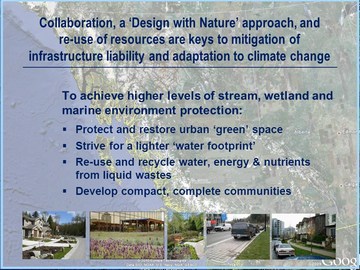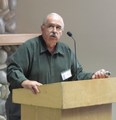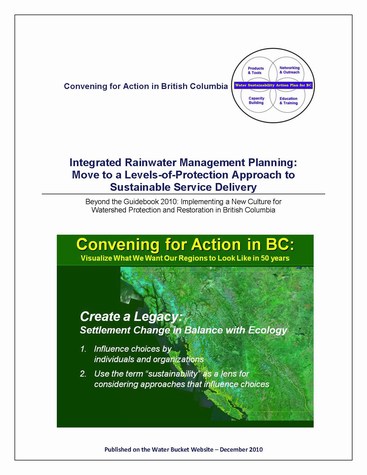Integrated Rainwater Management: Move to a Levels-of-Service Approach to Sustainable Drainage Infrastructure
Note to Readers:
During the November-December 2010 period, the Water Sustainability Action Plan for British Columbia released a series of five articles that are designed to inform local governments and others about a ‘course correction’ for Integrated Stormwater Management Plans (ISMPs).
The fourth in the series introduced the ‘infrastructure deficit’ (i.e. ‘infrastructure liability’) as a driver for the ISMP Course Correction. It connected the dots to Asset Management as a way to re-focus the ISMP process on what really matters. This led to an article in the Asset Management BC Newsletter, published in January 2011. Extracts from that article are reproduced below. To download the complete article, click here.

Prepare Communities for Change
The term Sustainable Service Delivery describes a life-cycle way of thinking about infrastructure needs and how to pay for those needs over time. The link between infrastructure asset management and the protection of a community’s natural resources is emerging as an important piece in Sustainable Drainage Infrastructure.
The Province’s Living Water Smart and Green Communities initiatives constitute an over-arching policy framework that encompasses both the ‘ISMP course correction’ and infrastructure asset management. They are preparing communities for change: start with effective green infrastructure and restore the urban fabric. Actions and targets in Living Water Smart encourage ‘green choices’ that will foster a holistic approach to infrastructure asset management.
Embrace a Level-of-Service Approach
‘Level-of-Service’ is the integrator for everything that local governments do. What level of service does a community wish to provide, and what level can it afford? Everyone will have to make level-of-service choices. Thus, a guiding principle could be framed this way:
- Establish the level-of-service that is sustainable to protect watershed health, and then work backwards to determine how to achieve that level of protection and level of drainage service.
The process of establishing an acceptable ‘Level-of-Service’ will require local governments to reassess the rationale for existing practices and standards; and determine whether and what changes may be necessary in future to achieve a balance between cost, affordability and community willingness to pay.
Improve the Resiliency of Communities
Local governments have an opportunity to mitigate the infrastructure deficit (i.e. infrastructure liability) and adapt to climate change within existing legislative authority and by means of a ‘design with nature’ approach to green infrastructure practices, respectively. The combination will improve the resiliency of communities.
Thus, a watershed-based plan that is outcome-oriented is a vehicle for local government to strategically connect the dots between land use planning, development and infrastructure standards, and infrastructure asset management. And by ‘designing with nature’, a local government could make a very strong case for having a higher level of service, at a lower life-cycle cost, with ‘assets’ that appreciate, not depreciate.
To Learn More:
To access and download a copy of the complete article as published in the Asset Management BC Newsletter, click on Integrated Rainwater Management: Move to a Levels-of-Service Approach to Sustainable Service Delivery. To learn more about the implications of the infrastructure liability:
 “Asset management usually commences after something is built. The challenge is to think about what asset management entails BEFORE the asset is built,” states Stan Westby, Chair of the Local Government Asset Management Working Group and Chief Administrative Officer with the City of Powell River.
“Asset management usually commences after something is built. The challenge is to think about what asset management entails BEFORE the asset is built,” states Stan Westby, Chair of the Local Government Asset Management Working Group and Chief Administrative Officer with the City of Powell River. “Land use planning in British Columbia may be significantly improved when integrated with asset management planning in local governments,” states Kim Fowler, Director of Sustainability for the City of Victoria, and a member of the Local Government Asset Management Working Group.
“Land use planning in British Columbia may be significantly improved when integrated with asset management planning in local governments,” states Kim Fowler, Director of Sustainability for the City of Victoria, and a member of the Local Government Asset Management Working Group. “People ‘hear’ the word ‘deficit’ and assume the accountants will fix it all. But people ‘listen’ to the word ‘liability’ and often ask questions or realize some action is necessary,” states Wally Wells, Coordinator for Asset Management BC.
“People ‘hear’ the word ‘deficit’ and assume the accountants will fix it all. But people ‘listen’ to the word ‘liability’ and often ask questions or realize some action is necessary,” states Wally Wells, Coordinator for Asset Management BC.
For more information on the 5-part ISMP Course Correction Series, click on Water Bucket publishes excerpts from “Beyond the Guidebook 2010” about why and how to re-focus ISMPs on outcomes — Outcome-oriented planning is a problem-solving PROCESS. It is not a procedure. It is not a matter of applying a regulation or a checklist. Participants have to be committed to the outcome.

Posted January 2011

